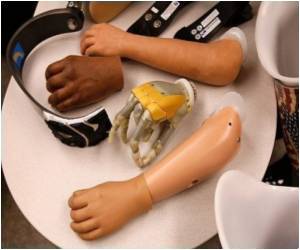Highlights:
- Despite several advances in prosthetic limbs, a fundamental problem remains: amputees must deal with the fact that they are unable to feel with their artificial arms or hands.
- While using a prosthetic limb, amputees must closely watch their own movement and the position of that limb at all times to avoid errors in movement such as overreaching.
- Novel device able to turn on patient’s sensation of movement to control their bionic arms better with ability to perform finer movements and multi-task better while using the limb.
"By restoring the intuitive feeling of limb movement - the sensation of opening and closing your hand - we are able to blur the lines between what the patients' brains perceived as 'self' versus 'machine'," said Marasco, head of the Laboratory for Bionic Integration in Cleveland Clinic's Lerner Research Institute. "These findings have important implications for improving human-machine interactions and bring us closer than ever before to providing people with amputation with complete restoration of natural arm function."
Aim of the Study
By feeling their missing hands while controlling their bionic prostheses, amputees could produce complex grip patterns and perform specific tasks equally well if not better than able-bodied people.To improve the relationship between the mind and the prosthesis, and make it function like a natural limb, the team investigated whether they could employ illusory movement to help patients achieve better control over their bionic limbs.
Methods of the Study
- The team studied six patients who had previously undergone targeted nerve reinnervation (TMR), developed as a novel strategy to improve control of myoelectric upper limb prostheses
- When they vibrated the patients' re-innervated muscles (by means of robotic devices) to provide illusory movement, these patients were not only able to feel the missing limb move but use this sensation to guide and control their prosthetic arm to perform movements more accurately and with better coordination.
Critical Difference Between Normal Limb and Prosthetic Limb
When a normal person moves his limb, the brain constantly receives feedback regarding the movement's position and progress. This unconscious mechanism prevents errors in judgment, like overreaching, and allows the body to make necessary corrections on time.Amputees lose this critical feedback, however, and as a result, cannot control their prostheses without having to constantly and carefully watch their movement and position of the prosthesis.
"When you make a movement and then you feel it occur, you intrinsically know that you are the author of that movement and that you have a sense of control or 'agency' over your actions," said Marasco. "People who have had an amputation lose that feeling of control, which leaves them feeling frustrated and disconnected from their prosthetic limbs. The illusions we generate restore the sensation of movement and re-establish their sense of agency over their prosthetics. This helps people with amputation to feel more in control."
Targeted Muscle Re-innervation
Targeted muscle reinnervation (TMR) was developed as a novel tool to gain better control of myoelectric upper limb prostheses.During this procedure, nerves found in the remaining upper arm or shoulder that had earlier controlled the amputated portion of the arm and hand are transplanted (reassigned) to a target muscle (e.g.: pectoral muscle), that is functional, but not able to perform its primary function due to the amputation. These reassigned nerves then gain control over the targeted muscle, which contract in response to brain signals for the missing limb.
TMR has been extensively studies in high-level upper limb amputations and has been shown to improve functional prosthesis control.
Future Plans
The research team is finding ways to expand these techniques in patients who have lost a leg, as well as neurological conditions that affect sensation such as stroke.The team plans to integrate the system into a prosthesis for longer-term applications to help patients use it on a daily basis.
"The ultimate goal of our research is to use movement sensation to streamline the relationship between patients and their technology, to better integrate their prosthetics as a natural part of themselves," said Marasco.
In conclusion, if this prototype system becomes available for routine clinical use, it could be a major achievement in improving the quality of life and independence of the thousands of persons who have lost a limb due to various causes.
Reference:
- Helping Amputees ‘Feel’ Through Their Artificial Arms - (https://www.lerner.ccf.org/bme/research/11.php)
Source-Medindia














